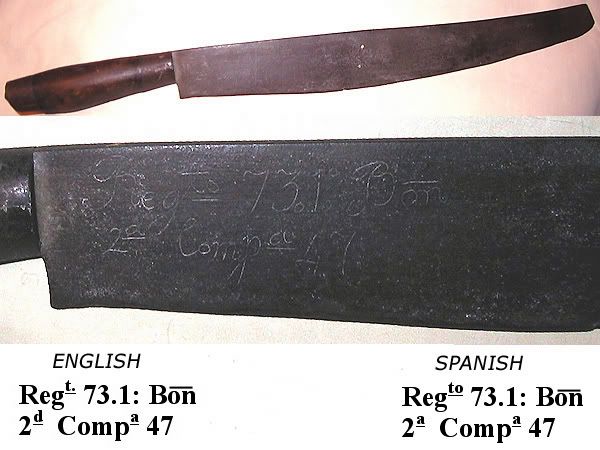
 |
|
|
#1 |
|
Vikingsword Staff
Join Date: Dec 2004
Location: The Aussie Bush
Posts: 4,512
|
I posted this one over on the SFI military swords site, only to be told that what I thought was an inscription in English was most likely Spanish.
http://forums.swordforum.com/showthr...threadid=49980 Moreover, the knife is not a standard military pattern and it was suggested that I consider Latin America or another Spanish colonial area of influence, including the Philippines. So what do you guys think? Description This is an old knife that I purchased recently from a dealer in the US. He found it in an estate. The blade is heavy and has been used in the remote past, with evidence of sharpening and loss of metal in places along the edge. The blade is sharpened on one side only, with the back being flat and the edge on the face being rounded rather than beveled (not exactly a chisel grind). Definitely a hand forged blade and not an armory production -- no stamps or maker's marks. The handle is wood with an iron ferrule either end. The hilt is full tang, and the tang is peened over a small butt plate. The handle has an ovoid cross section, with quite a prominent ridge running along the underside. OAL 19.5 in. Blade 14.25 in. A faint, hand-engraved inscription on the blade is difficult to make out (see picture) but I believe it indicates: Regiment 73.1 2nd Battalion Company 47 The style of hand writing strikes me as 19th C. or earlier. Pictures Juan Perez over on SFI made this comment: "In case it helps, I'd say that the inscription is written in Spanish. Therefore you can find Regto (=Regimiento), Bón (=Batallón), 2ª (=segunda) and Compª (=Compañía), which has of course the same meaning you have pointed out before." The Spanish version has been added at the bottom of the pictures, along with my original English interpretation. Any ideas when and where this knife may have originated? Ian.  |
|
|

|
|
|